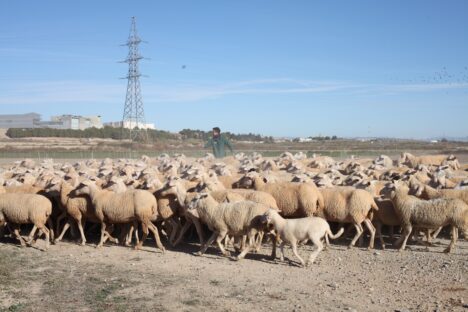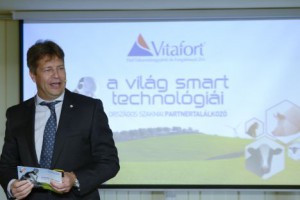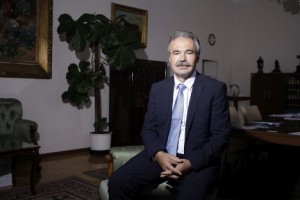Innovative Spanish farmer supplies tasty lamb to the whole world
 Spain accounts for more than a quarter of sheep meat production in the European Union (EU). About 10 percent is produced by farmers in Aragon. One of the members of a lamb cooperative there is the innovative sheep farmer Antonio Enfedaque. Nieuwe Oogst visited his company in November.
Spain accounts for more than a quarter of sheep meat production in the European Union (EU). About 10 percent is produced by farmers in Aragon. One of the members of a lamb cooperative there is the innovative sheep farmer Antonio Enfedaque. Nieuwe Oogst visited his company in November.
A lot of spectacle and shouting, but beautiful to see: moving a herd of a thousand sheep to a fresh plot of alfalfa under the supervision of a few border collies. In addition, two shepherds wave a stick around to direct the sheep to their new place. Nieuwe Oogst was there during a press trip for European agricultural journalists to the Aragón region in northeastern Spain at the end of November.
The company of Antonio Enfedaque (61), a farmer through and through for many years, is located near Zaragoza. Since 1981 he has focused entirely on keeping sheep. In 2000, Enfedaque joined the local lamb cooperative Pastores Grupo Cooperativo at the same time as several other sheep farmers in the area. That turned out to be a successful step. The cooperative is now known as one of the leading sheep sectors in the EU.
Together with his two sons, Enfedaque cares for three thousand sheep for the production of lamb called Ternasco de Aragón, classified as a Protected Geographical Indication (PGI). PGI is a legal recognition of the EU that guarantees the origin and quality of certain food products.
Pastores Grupo Cooperativo is the main producer and marketer of Ternasco de Aragón. It is also currently the best-selling lamb in Spain. Figures presented during the visit to the main building of Pastores Grupo Cooperativo in Zaragoza show that Spain accounts for more than a quarter of the EU’s sheep meat production.
The share seen worldwide is almost 10 percent. Andalusia is the largest Spanish sheep region with a share of 13.6 percent, followed by Aragón, figures for the year 2022 show. Ternasco de Aragón was created in 1989 to promote and market lamb from indigenous breeds raised in the Aragón region.
Ternasco de Aragón is made from the meat of young lambs selected for slaughter when they are less than 3 months old. The lambs were raised on mother’s milk for forty days. The indigenous sheep breed on the Enfedaque farm is Rasa Aragonesa.
These sheep are characterized by their short wool, the ability to graze and their adaptability to the sometimes harsh and cold weather conditions on the land. The sheep are outside all year round. Furthermore, the breed is known for its good meat production.
“Our sheep mainly graze on alfalfa,” explains Enfedaque. ‘We farm here on drought-sensitive soil and the deep-rooted alfalfa can deal with that best. Fortunately, the sheep also like to eat it.’ Spain experienced an extremely dry growing season last year, which forced the farmer to import some of the feed. April 2023 was even the warmest and driest April since 1961, the year in which weather data began to be kept.
In the summer the Spaniard irrigates extremely dry areas. Enfedaque tries to graze his sheep on those plots as much as possible during drought. The land is owned by the local municipality, which manages its use. The plots are located within a radius of 10 to 15 kilometers around the company, with the largest areas located closest to the farm.
But is grazing still possible in Spain without danger? Wolves are living in more and more areas in the Netherlands and this has already cost the lives of many sheep. In Spain too, the wolf is becoming increasingly visible in areas where the animal previously did not or hardly occur. According to the website ‘Spain Today’, the number of wolves in Spain has increased by almost a quarter in ten years. It is estimated that there are approximately 2,800 wolves. Most are located in northwestern Spain. But the animal is also being spotted more and more often in Aragon, as can be read on the website.
Enfedaque follows the news closely. Last summer, a wolf appeared out of nowhere about 15 kilometers away. So far, the animal has ‘only’ grazed a few sheep there. ‘Specialists think it is an alien wolf from Italy. To prevent new problems with the animal, farmers place a wolf-resistant grid there with a lot of electricity on it. I hope I never have to post it here,” says the sheep farmer. He therefore simply lets the animals graze in the meadow for the time being.
In addition to wolf attacks, Dutch sheep farmers also had to deal with bluetongue from October 2023. From then on, this non-contagious viral disease spread rapidly. Hundreds of farms were affected and the outbreak of serotype 3 has already killed more than 50,000 sheep.
In the months of September and October it was warmer than average, which meant that the midges that spread bluetongue were active for longer. With the arrival of winter, the number of cases of bluetongue has decreased again since November and the infections currently seem to be calm.
According to Enfedaque, the problems with bluetongue in Northern Spain are not too bad. In contrast to the north, there were cases of bluetongue in southern Spain just before winter. “The sheep are vaccinated there,” says Enfedaque. ‘There is a vaccination program from the government. Just like in the Netherlands, this concerns type 3, but other types are also checked. I have not seen it yet at our company and in this area. We did have an outbreak here at the end of 2008.’
So most sheep are always outside, except for the lambs selected for slaughter. Enfedaque invested in a new stable about seven years ago to accommodate slaughter lambs. This modern housing is equipped with, among other things, an automatic feeding system. Especially for the little concentrate that the animals still receive.
All in all, the construction cost him 400,000 euros, part of which the entrepreneur paid out of his own pocket and part with borrowed money. The farm had an annual turnover of 250,000 euros in 2022. During the press trip at the end of November, the turnover for 2023 was not yet known, but it was expected at the time that it would be higher due to the price increase of lamb.
Part of the work on the company is therefore automated. But despite this, Enfedaque has its hands full with farming. Working days of 14 or 15 hours are very common. ‘It is difficult to find staff in this region. Young people are increasingly moving to cities or elsewhere in the country. The problem will therefore only become worse in the future.’
Aragon is a sparsely populated region. There is an average of 5 inhabitants per square kilometer. For comparison: the average population density in the Netherlands is 529 inhabitants per square kilometer. “Only single farmers’ sons hang around here,” Enfedaque winks at his son, who can’t help but laugh about it.
In addition to the automatic feeding system for the slaughter lambs, the entrepreneur saves labor with an innovative detection system. A microchip is inserted into the lambs and remains in the abdomen at all times. Enfedaque can read every chip via a connection with Bluetooth. The reading device shows, among other things, the date of birth and gender. In addition, the device indicates whether the sheep is pregnant or not. If she is pregnant, the system also indicates how many lambs are in the womb.
Furthermore, the high labor demand on the company can be partly met by the services provided by the marketing cooperative Pastores Grupo Cooperativo. This offers service to all member livestock farmers, regardless of their size and distance from the main building. Enfedaque sees Pastores Grupo Cooperativo as an important foundation in the sector. ‘Not only does it supply animal supplies and advice in the areas of health, genetics and feed, but we can also use cooperative employees for insemination. That’s very nice,” he concludes.










